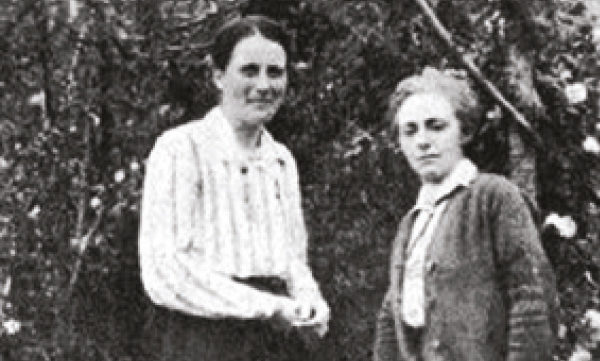
By Dermot Carmody
NewsFour attended a talk given on Wednesday July 3rd by Maeve Casserly, Historian In Residence for Southeast Dublin, about notable women associated with the area from mainly 20th century history. Maeve’s talk was entitled Surgeons, Starlets and Suffragettes, a title reflecting the diversity of the women in question.
The talk mentioned many women associated with Rathmines and environs, including the several residents of Belgrave Road, or Rebel Road as it became known, so prominent were its insurgent residents.
Dr. Kathleen Lynn ran her general practice in 9 Belgrave Road, where she lived with her partner Madeleine ffrench-Mullen. Both were members of the Irish Citizens Army and Dr. Lynn was the ICA’s chief medical officer during the 1916 Rising.
Both were imprisoned in Kilmainham for their part in the Rising and Dr. Lynn was deported to England for a time. She returned to re-establish her Belgrave Road practice.
She was vice-president of Sinn Féin and was elected TD for Dublin County in 1923. Lynn co-founded St. Ultan’s Children’s Hospital, which was entirely run by women, in Charlemont in 1919.
Dorothy Stopford Price was another important woman associated with St. Ultan’s. She lived with her husband in FitzWilliam place and in later years at 8 Herbert Park. They moved there after Dorothy suffered a stroke and the grand house in FitzWilliam place became unmanageable.
She pioneered the use of tuberculin testing for TB in Ireland, along with the use of the BCG vaccine to immunise children. In 1937, a BCG vaccination programme was run from St. Ultan’s and in 1949, Price became the first chairperson of the Irish National BCG Committee.
Another Rathmines revolutionary was Constance Gore Booth (Countess Markievicz). She was a close associate of James Connolly and joined his Irish Citizen’s Army, formed during the 1913 Lock Out.
Connolly lodged with her at Surrey House in Leinster Road and published The Spark and The Worker’s Republic from her printing press there. Constance fought mainly at St. Stephen’s Green in the Rising and was subsequently jailed. She was elected a member of the first Dáil and served as Minister for Labour.
One of Countess Markievicz’s neighbours in Leinster Road was Anna Haslam. Anna and her husband Thomas were from a different reforming tradition, regarding themselves as suffragists rather than the more radical activism of the suffragettes. Anna campaigned for social and political reform from the mid 19th century and was celebrated by all shades of political activism, when at almost 90 she went to vote for the first time in the 1918 general election.
Worth mentioning too is Elizabeth O’Farrell, nurse and rebel, who was literally airbrushed out of a photograph of Padraig Pearse surrendering at the end of the 1916 Rising and who is therefore perhaps emblematic of the masculine prism through which history is too often viewed.
As well as tending the wounded during the Rising, O’Farrell and others acted as despatchers through the perilous streets. It was she who approached the British from the GPO under a white flag seeking to surrender.
Maeve Casserly’s tour of notable women from Southeast Dublin was not confined to rebels and social reformers, however. Women in the arts were also celebrated including Maureen O’Hara, born in Beechwood Avenue in Ranelagh and perhaps most famous for her role alongside John Wayne in The Quiet Man.
O’Hara is very much a figure of local folklore in Ranelagh and as recently as 2010 she was pictured opening the Ranelagh Arts Festival that year, her neck proudly adorned with a Shamrock Rovers scarf. Her father had bought a stake in Rovers when she was a child. She remained a lifelong supporter of the club.
Another Ranelagh native who became famous in the USA was Maeve Brennan. Moving to New York in the 1940s, Brennan was a writer at Harper’s Bazaar and then at The New Yorker. Her witty prose was much admired. Sadly, she grew ill in the 1970s and by the 1980s was destitute until she died in a nursing home in 1993.
Painting and fashion design were represented in the talk by Sarah Purser and Sybill Connolly. Purser lived in 19 Wellington Road and had a studio at the Grand Canal end of Harcourt Terrace. A notable portrait painter, her portrait of Constance and Eva Gore Booth sold for an unexpectedly high €200,000 in 2018. Purser was also instrumental in the setting up of the Hugh Lane Gallery.
Sybill Connolly, who lived in 71 Merrion Square, became famous for her designs, typically using traditional Irish fabrics such as linen, tweed and lace. Her clothes were worn by Julie Andrews, Elizabeth Taylor and most famously by Jacqueline Kennedy, when the President’s wife sat for an official White House portrait.
Surgeons, Starlets and Suffragettes provided an interesting starting point from where one could delve deeper into the stories of these women and others which time and history excluded. Maeve Casserly returns to Ringsend Library in August for a further talk, this time focussing on domestic life in Dublin during the First World War.
Maeve Casserly, Historian In Residence for Southeast Dublin will give her talk Food Fuel And Making Do in Ringsend Library on Wednesday August 14th at 6.30pm.



